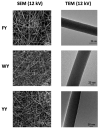Peptide-Based Electrospun Fibers: Current Status and Emerging Developments
- PMID: 34065019
- PMCID: PMC8151459
- DOI: 10.3390/nano11051262
Peptide-Based Electrospun Fibers: Current Status and Emerging Developments
Abstract
Electrospinning is a well-known, straightforward, and versatile technique, widely used for the preparation of fibers by electrifying a polymer solution. However, a high molecular weight is not essential for obtaining uniform electrospun fibers; in fact, the primary criterion to succeed is the presence of sufficient intermolecular interactions, which function similar to chain entanglements. Some small molecules able to self-assemble have been electrospun from solution into fibers and, among them, peptides containing both natural and non-natural amino acids are of particular relevance. Nowadays, the use of peptides for this purpose is at an early stage, but it is gaining more and more interest, and we are now witnessing the transition from basic research towards applications. Considering the novelty in the relevant processing, the aim of this review is to analyze the state of the art from the early 2000s on. Moreover, advantages and drawbacks in using peptides as the main or sole component for generating electrospun nanofibers will be discussed. Characterization techniques that are specifically targeted to the produced peptide fibers are presented.
Keywords: electrospinning; peptide-based electrospun nanofibers; peptides; peptidomimetics; self-assembly.
Conflict of interest statement
The authors declare no conflict of interest.
Figures















Similar articles
-
Peptide grafting strategies before and after electrospinning of nanofibers.Acta Biomater. 2021 Mar 1;122:82-100. doi: 10.1016/j.actbio.2020.11.051. Epub 2020 Dec 14. Acta Biomater. 2021. PMID: 33326882 Review.
-
Recent advances in electrospinning supramolecular systems.J Mater Chem B. 2021 Dec 22;10(1):8-19. doi: 10.1039/d1tb02304g. J Mater Chem B. 2021. PMID: 34878489 Review.
-
Natural protein-based electrospun nanofibers for advanced healthcare applications: progress and challenges.3 Biotech. 2022 Apr;12(4):92. doi: 10.1007/s13205-022-03152-z. Epub 2022 Mar 14. 3 Biotech. 2022. PMID: 35342680 Free PMC article. Review.
-
Electrospinning of pyrazole-isothiazole derivatives: nanofibers from small molecules.RSC Adv. 2019 Jul 2;9(36):20565-20572. doi: 10.1039/c9ra02486g. eCollection 2019 Jul 1. RSC Adv. 2019. PMID: 35515570 Free PMC article.
-
Fabrication of nanofibrous electrospun scaffolds from a heterogeneous library of co- and self-assembling peptides.Acta Biomater. 2017 Mar 15;51:268-278. doi: 10.1016/j.actbio.2017.01.038. Epub 2017 Jan 16. Acta Biomater. 2017. PMID: 28093364
Cited by
-
Non-Conventional Peptide Self-Assembly into a Conductive Supramolecular Rope.Nanomaterials (Basel). 2023 Jan 13;13(2):333. doi: 10.3390/nano13020333. Nanomaterials (Basel). 2023. PMID: 36678086 Free PMC article.
-
Solvent modulation in peptide sub-microfibers obtained by solution blow spinning.Front Chem. 2022 Dec 6;10:1054347. doi: 10.3389/fchem.2022.1054347. eCollection 2022. Front Chem. 2022. PMID: 36561144 Free PMC article.
-
Biomimetic Electrospun Self-Assembling Peptide Scaffolds for Neural Stem Cell Transplantation in Neural Tissue Engineering.Pharmaceutics. 2023 Aug 31;15(9):2261. doi: 10.3390/pharmaceutics15092261. Pharmaceutics. 2023. PMID: 37765230 Free PMC article.
-
Agro-Industrial Plant Proteins in Electrospun Materials for Biomedical Application.Polymers (Basel). 2023 Jun 14;15(12):2684. doi: 10.3390/polym15122684. Polymers (Basel). 2023. PMID: 37376328 Free PMC article. Review.
-
Significant Electromechanical Characteristic Enhancement of Coaxial Electrospinning Core-Shell Fibers.Polymers (Basel). 2022 Apr 25;14(9):1739. doi: 10.3390/polym14091739. Polymers (Basel). 2022. PMID: 35566908 Free PMC article.
References
-
- Reneker D.H., Yarin A.L. Electrospinning jets and polymer nanofibers. Polymer. 2008;49:2387–2425. doi: 10.1016/j.polymer.2008.02.002. - DOI
-
- Singer J.C., Ringk A., Giesa R., Schmidt H.-W. Melt Electrospinning of Small Molecules. Macromol. Mater. Eng. 2015;300:259–276. doi: 10.1002/mame.201400296. - DOI
Publication types
LinkOut - more resources
Full Text Sources

